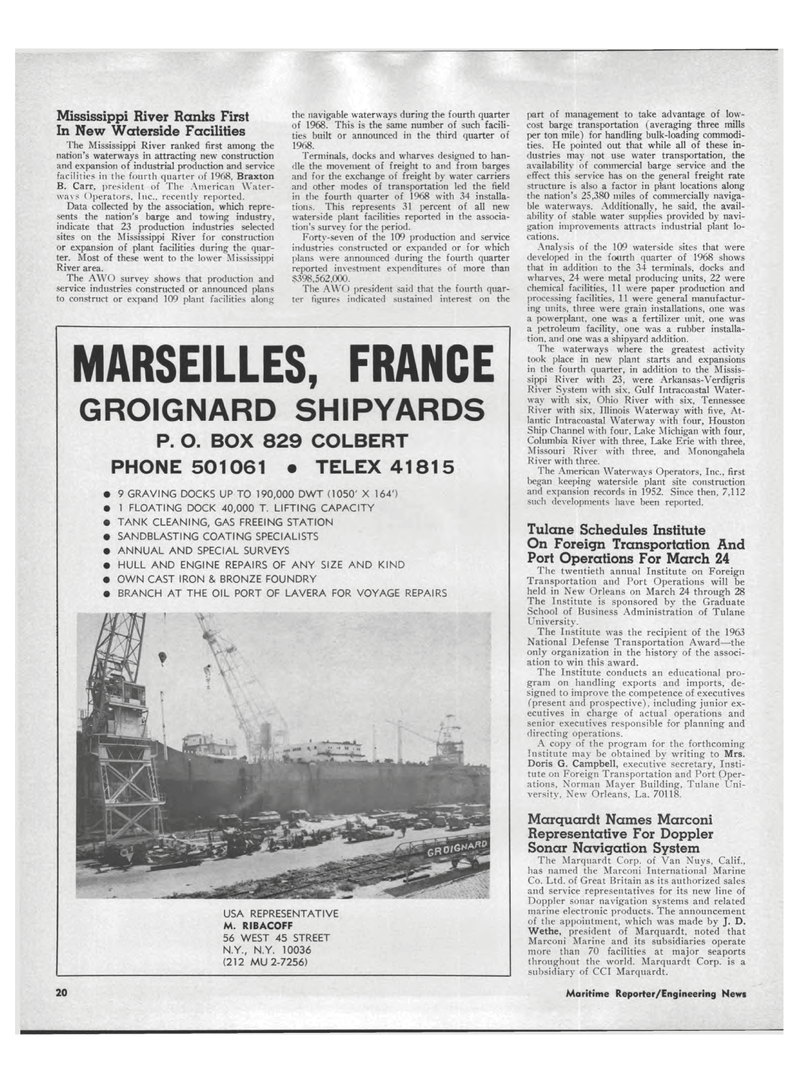
Page 18: of Maritime Reporter Magazine (March 1969)
Read this page in Pdf, Flash or Html5 edition of March 1969 Maritime Reporter Magazine
Mississippi River Ranks First In New Waterside Facilities The Mississippi River ranked first among the nation's waterways in attracting new construction and expansion of industrial production and service facilities in the fourth quarter of 1968, Braxton B. Carr, president of The American Water-ways Operators. Inc.. recently reported. Data collected by the association, which repre-sents the nation's barge and towing industry, indicate that 23 production industries selected sites on the Mississippi River for construction or expansion of plant facilities during the quar-ter. Most of these went to the lower Mississippi River area. The AWO survey shows that production and service industries constructed or announced plans to construct or expand 109 plant facilities along the navigable waterways during the fourth quarter of 1968. This is the same number of such facili-ties built or announced in the third quarter of 1968. Terminals, docks and wharves designed to han-dle the movement of freight to and from barges and for the exchange of freight by water carriers and other modes of transportation led the field in the fourth quarter of 1968 with 34 installa-tions. This represents 31 percent of all new waterside plant facilities reported in the associa-tion's survey for the period. Forty-seven of the 109 production and service industries constructed or expanded or for which plans were announced during the fourth quarter reported investment expenditures of more than $398,562,000. The AWO president said that the fourth quar-ter figures indicated sustained interest on the part of management to take advantage of low-cost barge transportation (averaging three mills per ton mile) for handling bulk-loading commodi-ties. He pointed out that while all of these in-dustries may not use water transportation, the availability of commercial barge service and the effect this service has on the general freight rate structure is also a factor in plant locations along the nation's 25,380 miles of commercially naviga-ble waterways. Additionally, he said, the avail-ability of stable water supplies provided by navi-gation improvements attracts industrial plant lo-cations. Analysis of the 109 waterside sites that were developed in the fourth quarter of 1968 shows that in addition to the 34 terminals, docks and wharves, 24 were metal producing units, 22 were chemical facilities, 11 were paper production and processing facilities, 11 were general manufactur-ing units, three were grain installations, one was a powerplant. one was a fertilizer unit, one was a ]>etroleum facility, one was a rubber installa-tion. and one was a shipyard addition. The waterways where the greatest activity took place in new plant starts and expansions in the fourth quarter, in addition to the Missis-sippi River with 23, were Arkansas-Verdigris River System with six, Gulf Intracoastal Water-way with six, Ohio River with six, Tennessee River with six, Illinois Waterway with five, At-lantic Intracoastal Waterway with four, Houston Ship Channel with four. Lake Michigan with four, Columbia River with three. Lake Erie with three, Missouri River with three, and Monongahela River with three. The American Waterways Operators, Inc., first began keeping waterside plant site construction and expansion records in 1952. Since then. 7,112 such developments have been reported. Tulane Schedules Institute On Foreign Transportation And Port Operations For March 24 The twentieth annual Institute on Foreign Transportation and Port Operations will be held in New Orleans on March 24 through 28 The Institute is sponsored by the Graduate School of Business Administration of Tulane University. The Institute was the recipient of the 1963 National Defense Transportation Award?the only organization in the history of the associ-ation to win this award. The Institute conducts an educational pro-gram on handling exports and imports, de-signed to improve the competence of executives (present and prospective), including junior ex-ecutives in charge of actual operations and senior executives responsible for planning and directing operations. A copy of the program for the forthcoming Institute may be obtained by writing to Mrs. Doris G. Campbell, executive secretary, Insti-tute on Foreign Transportation and Port Oper-ations, Norman Mayer Building, Tulane Uni-versity, New Orleans, La. 70118. Marquardt Names Marconi Representative For Doppler Sonar Navigation System The Marquardt Corp. of Van Nuys, Calif., has named the Marconi International Marine Co. Ltd. of Great Britain as its authorized sales and service representatives for its new line of Doppler sonar navigation systems and related marine electronic products. The announcement of the appointment, which was made by J. D. Wethe, president of Marquardt, noted that Marconi Marine and its subsidiaries operate more than 70 facilities at major seaports throughout the world. Marquardt Corp. is a subsidiary of CCI Marquardt. MARSEILLES, FRANCE GROIGNARD SHIPYARDS P. O. BOX 829 COLBERT PHONE 501061 ? TELEX 41815 ? 9 GRAVING DOCKS UP TO 190,000 DWT (1050' X 164') ? 1 FLOATING DOCK 40,000 T. LIFTING CAPACITY ? TANK CLEANING, GAS FREEING STATION ? SANDBLASTING COATING SPECIALISTS ? ANNUAL AND SPECIAL SURVEYS ? HULL AND ENGINE REPAIRS OF ANY SIZE AND KIND ? OWN CAST IRON & BRONZE FOUNDRY ? BRANCH AT THE OIL PORT OF LAVERA FOR VOYAGE REPAIRS USA REPRESENTATIVE M. RIBACOFF 56 WEST 45 STREET N.Y., N.Y. 10036 (212 MU 2-7256) 20 Maritime Reporter/Engineering News

 17
17

 19
19
